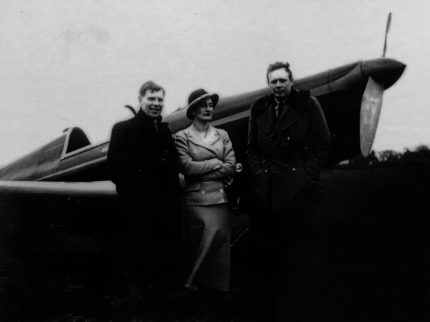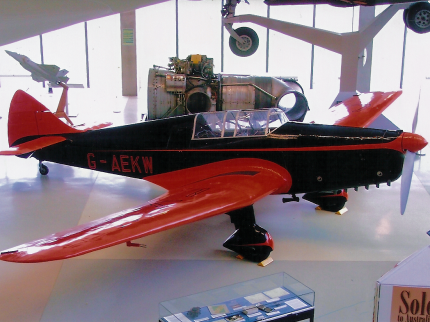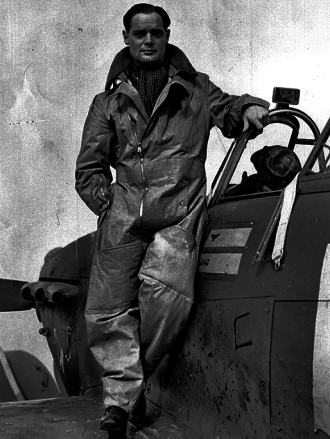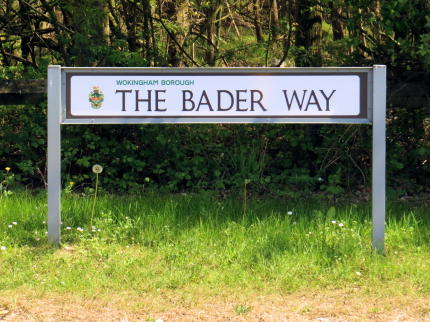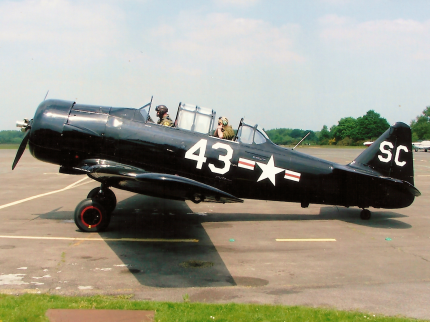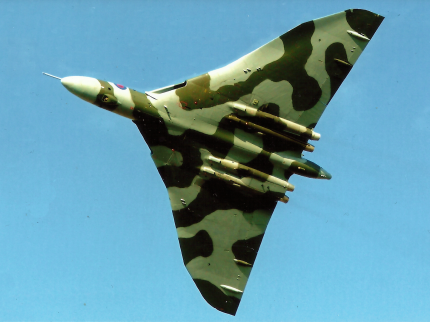
Woodley Airfield
Woodley Airfield and Miles Aircraft
In the 1930s Jack Phillips and Charles Powis founded the company Phillips and Powis Aircraft at Woodley Airfield. In 1932 Charles Powis met aircraft designer Fredrick George Miles, or FG Miles, He was subsequently married to Maxine ‘Blossom’ Freeman-Thomas.
In 1933 Phillips and Powis built an aircraft called the Hawk which had been designed by FG and Blossom Miles. Later the couple joined the company with Miles Aircraft successfully producing some record-breaking. and race-winning aircraft. In 1935, the company went public with financial support from Rolls-Royce Ltd.
FG and Blossom Miles with Charles Lindbergh along with his Mohawk aircraft
In 1936, Charles Lindbergh visited the airfield and asked Miles to design a light aircraft for him and his wife to use on European business trips. The aircraft was named the Mohawk.
Miles M.12 Mohawk
The company went from strength to strength with such aircraft as the Magister, Master and Martinet receiving large orders from the Air Ministry.
In 1941, Rolls-Royce sold its shares to FG Miles who became chairman. Blossom and FGs brother George becoming directors. Two years later the company officially became Miles Aircraft Ltd.
Miles Martinet
Following the end of the Second World War, all aircraft manufacturers faced falling orders and Miles Aircraft were no exception. Sadly in 1948 the company was wound up.
47 different Miles aircraft types were designed and 5,644 aircraft of their designs were produced between 1929 and 1946. One of the most exciting projects was the M.52 supersonic experimental aircraft. It had reached flying scale model stage and had achieved Mach 1·38. Sadly it was cancelled before full-size prototypes could be built.
Charles Lindbergh’s Mohawk
Sometime after his triumphant crossing of the Atlantic in his aircraft The Spirit of St Louis, Lindbergh moved to England. He approached George Miles to design a one-off aircraft for him to tour Europe with his wife Anne.
The result was the Miles Mohawk, a tandem two-seat monoplane built in 1936 specifically for Lindbergh. The aviator wanted a small, fast, long-range aircraft. It was registered G-AEKW and first flew 22 August 1936. It was powered by a 200hp Menasco Buccaneer B6S engine and had a maximum speed of 190mph. Lindbergh and his wife Anne first went on a trip to India in the machine and later toured Europe. In April 1939 Lindbergh flew the machine for the last time, bringing it home to Woodley for storage whilst he and his wife returned to the USA. In late 1941 it was commandeered into service as a communications aircraft with the RAF and given the military registration HM503. It saw little military service and in early 1944 it was delivered to 5 MU at RAF Kemble for storage.
Photographer unknown – PfS/MoBA 11/01/2017
Miles Mohawk G-AEKW at Hendon
The aircraft was bought by Southern Aircraft (Gatwick) Ltd who restored it flew and won second place at the Folkstone Trophy Air Race. In 1949 it was taken to North Africa to take part in the Oran International Rally but it was forced to land in Spain never to fly again. Discovered in a junkyard near Seville and taken to the USA for restoration. In 2002 the Mohawk was shipped to the RAF Museum who displayed it at Hendon but currently keep it in storage.
Douglas Bader
Born on 21 February 1910 at St John’s Wood, Douglas Bader is one of the most famous pilots of all time. He joined the RAF in 1928 as an officer cadet. He took his first flight with an instructor in 1928 and flew his first solo in 1929. He became a Pilot Officer with 23 Sqn RAF flying Bristol Bulldogs.
Douglas Bader
Bader often flew illegal and dangerous stunts. Strict orders were issued forbidding unauthorised aerobatics below 2,000 feet. Bader took it as unnecessary safety rules rather than orders to be obeyed.
At Woodley Airfield on 14 December 1931, Bader tried some low-flying acrobatics in a Bulldog. The port wing of his aircraft caught the ground and he crashed. Bader was rushed to Royal Berkshire Hospital, where prominent surgeon J Leonard Joyce amputated both his legs.
In 1932, after a long convalescence, Bader was sent to the hospital at RAF Uxbridge and fitted with a pair of artificial legs. After some time he was able to drive a modified car.
Later that year it was arranged for him to take up an Avro 504, which he piloted competently. The RAF decided that his situation was not covered by King's Regulations, Bader was invalided out of the RAF and took a job with an oil company. In 1933 he married Thelma Edwards whom he had met during convalescence.
A road sign in Woodley dedicated to Bader
In 1939, Douglas Bader returned to the RAF as a pilot and fought in both the Battle of France and the Battle of Britain. In August 1941, Bader bailed out over France and was captured. He made a number of escape attempts until being sent to Colditz Castle. He remained there until April 1945 when the camp was liberated.
Bader left the RAF in February 1946. During the 1950s, a book and a film, Reach for the Sky, chronicled his life and RAF career to the end of the Second World War. Bader died aged 72 on 5 September 1982, following a heart attack.
Street names on housing estate with a direct link to Woodley Airfield
Blossom Grove – Possibly Blossom Miles aviation designer, wife of FG Miles
Gemini Road – Miles M.65 light touring aircraft
Miles Gemini G-AKEJ
Herald Way – Handley Page airliner
Marathon Close – Miles M.60/Handley Page HPR 1 light transport aircraft
Martinet Road – Miles M.25 target tug
Master Close – Miles M.9A/M.27 training aircraft
Messenger Road – Miles M.38 military liaison aircraft
Miles Way – Aviation manufacturer based on Woodley Airfield for some time
Mohawk Way – Miles M.12 light touring aircraft custom-made for Charles Lindbergh
Monitor Way – Miles M.33 target tug
Perimeter Road – marks some of the south-eastern edge of the former airfield
The Bader Way – Douglas Bader WW2 fighter ace who lost his legs at Woodley Airfield
Spitfire W3185 D-B of Wg Cdr Douglas Bader, 1941
Street names on housing estate with a link to aviation generally
Beaver Way – de Havilland Canada DHC-2 light utility aircraft
Buccaneer Close – Blackburn-built maritime strike aircraft
Catalina Close – Consolidated PBY Catalina flying boat
Comet Close – de Havilland DH 106, world’s first jet airliner
Concorde Way – world’s first supersonic airliner
Dowding Close – Air Chief Marshall Hugh Dowding in charge of Fighter Command during the Battle of Britain
Harrier Close – World’s first Vertical/Short Take-Off and Landing (V/STOL) fighter aircraft
Harris Close – Marshall of the RAF in charge of Bomber Command, known as ‘Bomber’ Harris
Harvard Close – US-built training aircraft from WW2
Photographer unknown – PfS/MoBA 11/01/2017
Harvard G-AZSC once belonged to Gary Numam
Hawker Way – Hawker Aircraft based at Langley during and post WW2
Hurricane Way – Hawker Hurricane, important fighter aircraft of WW2
Lindberg Way – (sign misspelt) Charles Lindbergh pioneer aviator, first to make a solo crossing of the Atlantic
Lysander Close – WW2 liaison/special operations aircraft built by Westland
Lysander V9289/C as flown by Flight Lieutenant Peter Arkell, a great-grandson of John Arkell, the founder of Arkell’s Brewery
Meteor Close – first RAF jet fighter, built during WW2 by Gloster
Mitchell Way – RJ Mitchell was the designer of the Spitfire
Nimrod Close – RAF maritime patrol aircraft developed from the Comet airliner
Orville Close – aviation pioneer along with his brother Wilbur Wright produced first successful heavier than air flying machine
Shackleton Way – RAF maritime patrol aircraft developed from the Lancaster bomber
Sopwith Close – aircraft manufacturer Sopwith Aviation Co founded by Thomas Sopwith
Spitfire Way – WW2 fighter aircraft of the RAF and many other forces
Sunderland Close – WW2 RAF maritime patrol flying boat
Vickers Close – aircraft manufacturer
Victor Way – RAF bomber or inflight refuelling tanker
Viscount Way – Turboprop airliner built by Vickers
Vulcan Close – RAF Delta-wing bomber built by Avro
Photographer unknown – PfS/MoBA 11/01/2017
Vulcan B2
Walrus Close – WW2 light utility seaplane
Wright Close – Orville and Wilbur Wright, aviation pioneers
Bombing of Woodley Airfield
Based on notes from the Operational Record Book of No 8 EFTS (Elementary Flying Training School) Woodley Airfield
16/08/1940 – One stick of 4 bombs dropped on south-west boundary of Woodley Aerodrome. Damage to RAF aircraft: one Magister set on fire and completely destroyed.
16/09/1940 – 10 bombs were dropped across Woodley Aerodrome, all of which failed to explode. Damage: nil. Casualties: nil
03/10/1940 – Enemy attack: 6 bombs dropped across centre of Woodley, 3 of which were delayed action. Damage to RAF Aircraft and equipment: nil. Casualties: nil.
06/10/1940 – Enemy attack – 2 bombs dropped in allotment 50 yards north of Woodley Aerodrome. Windows and hangar walls damaged. Damage to RAF Aircraft and equipment: nil. Casualties: nil.
In the last report there is no mention of damage to cabbages or other vegetables. You might think I’m being flippant but I’m rather partial to cabbage.
Acknowledgements
Many thanks for the help, support and guidance on this and other articles within this website to the Museum of Berkshire Aviation. For the latest information, opening days, times and the location of the museum, visit the homepage of their website by clicking on the button below:
Information contained in these pages is correct as of 2018
My name is Gary Flint. I'm author, photographer & illustrator for Postcards from Slough. If you wish to make any comments on the contents of the website please click on the ladybird below:
Gary Flint
08/03/1961 - 09/04/2019
Postcards from Slough is an independently funded website. We are open to offers of sponsorship from companies that have any connections to the town. To contact us please click on the ladybird below:
Chalvey Community Forum
Postcards from Slough is linked with a local action group the Chalvey Community Forum. The group liaises with various local organisations in order to improve the quality of life for residents in the ward of Chalvey and Salt Hill. To learn more please click on the maidenhair leaf below:
Museum of Berkshire Aviation
I volunteer as a guide at the Museum of Berkshire Aviation. It is a special museum and if you would like to know more about the museum then please click on the motif below:
To learn more about the museums activities while staying within this website click on the tab at the top of the page or on the motif below:
Graces Guide
Postcards from Slough uses some images from Grace's Guide. Click on the button below:
British Listed Buildings
Postcards from Slough contributes material to British Listed Buildings and uses the site for cross referencing purposes. Click on the button below:
